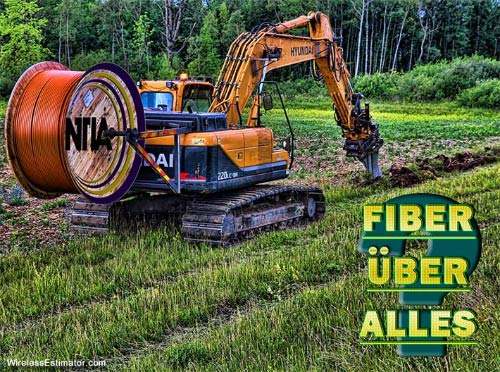
KEY BEAD PROGRAM ARCHITECT (from left) Senator Mark Warner of Virginia, Senior Advisor to U.S. Secretary of the Department of Commerce Kevin Gallagher, and Telecommunications Industry Association CEO Dave Stehlin will be featured speakers amongst almost 50 other speakers, moderators, and panelists at next week’s BEAD Summit. In an interview below, Stehlin provided his views on Buy America concerns and workforce shortage issues. Additional information regarding the summit is available here.
Recent trade shows have explored opportunities that will become available through the Broadband Access and Employment Program’s (BEAD) Notice of Funding Opportunity (NOFO), providing States approximately $42 billion to deploy broadband in America where it is not located. However, they were typically 45-minute sessions that often scratched the surface, leaving many unanswered questions.
Fortunately, the Telecommunications Industry Association (TIA) is providing a BEAD Success Summit on April 19 and 20 in Arlington, Virginia, that should give all attendees a head start on capturing federal funding.
TIA has assembled an A-list roster of speakers, including crucial BEAD Program architect Senator Mark Warner of Virginia and officials from the National Telecommunications and Information Association (NTIA), which is administering the program, to address critical questions surrounding the implementation of the BEAD Program.
The event will also provide wireless contractors and suppliers a unique opportunity to sit side-by-side with and meet state and territory broadband office officials that will be doling out the dollars, in addition to wireless, wireline, and satellite network operators.
 The NTIA appears to have a love affair with fiber by designating fiber as a “priority broadband project,” It could result in a $60 Billion boondoggle, according to a Wireless Internet Service Providers Association (WISPA) white paper.
The NTIA appears to have a love affair with fiber by designating fiber as a “priority broadband project,” It could result in a $60 Billion boondoggle, according to a Wireless Internet Service Providers Association (WISPA) white paper.
The topic will likely be broached at the two-day event featuring almost 50 speakers.
Equally as important are the subjects that will be addressed, such as: How will “Buy America” requirements factor into the success of BEAD deployments? How do states address new requirements around cybersecurity and supply chain issues? When will BEAD funds begin rolling out?
TIA CEO Dave Stehlin discusses wireless contracting and supplier issues
TIA CEO Dave Stehlin, who has spent the last year working with all of the critical stakeholders of the BEAD program to ensure the hot-button issues surrounding the initiative are being addressed and lead to a successful roll-out, discussed some of the problems aligned with wireless infrastructure contractors and their suppliers in advance of the summit with Wireless Estimator.
To identify a timeframe when the BEAD funding will be rolled out, Stehlin said it’s in three phases, and phase one has already been rolled out.
“Phase one is the planning money that each entity, each state, and territory gets. They applied for that last spring and summer, and that money is being rolled out to the various states,” Stehliin said.
He noted that most of the money is tied to the completion of the mapping exercise that the FCC has underway to show where the unserved and underserved areas are around the country.
“Based on percentages, that’s how the great majority of that $42 billion gets let. So the FCC, as recently as a week or two ago, said that they expect the final — what they call the final –version of the mapping results to come out next month. And NTIA has said that by the end of June, they will announce how much each state and territory will be getting based on the FCC mapping data,” Stehlin said.
“So then what happens is the states put together their initial proposal for how they’re going to spend the money, based on where those broadband gaps are, and then they’ve got basically six months from the time they’re told how much money they’re getting, to come out with that initial proposal, and then they start the process of finding internet service providers and contracting with them. And the money then starts getting let to the service providers, and I would expect early next year.”
Stehlin said there is “definitely a risk” that the Buy America requirements could hold the program back. He said fiber cable is not the issue; it’s the electronics, and “some people get confused by separating those two.”
“It’s the routers and switches in the home and the central office or the data center. It’s the RAN gear that’s being used for fixed wireless access. Those are the devices that do not meet the Made in America requirements. Yet without those electronics, you can’t transmit signals, so you can’t turn up a network,” said Stehlin.
Since fiber appears to be NTIA’s preferred stitching to close the digital divide, the need for macro towers will be limited, and manufacturers seem to be able to meet the Buy America requirements.
Steel and tower component requirements
Regarding towers, iron and steel used are required to be produced in the United States. “That means all manufacturing processes, from the initial melting stage through the application of coatings, all those things are supposed to occur in the United States,” said Stehlin.
However, whether ancillary attachment hardware and other items made overseas would require a waiver is unclear. To get one, the provider must identify that the items are not manufactured in the United States or that using those limited construction materials produced in the United States will increase the cost of the overall project by more than 25 percent.
Or, it may not be a concern.” There’s a discussion underway, and I will use a term that our lawyers use; if de minimis parts do not meet the requirement, that should still be okay. So what is de minimis? It’s a hazy term, I think, right? But I think, in essence, it means something that’s a really small percentage of the overall solution,” said Stehlin.
Although President Biden has multiple times identified that he wants to employ union labor to build out broadband. Stehlin doesn’t believe that it is a requirement.”
“In the Notice of Funding Opportunity, the rules call for fair labor practices. I don’t think it specifically calls out [labor] must be unionized. But the way it works is the eligible entities, meaning the states and the territories, are the ones that have to run the process and manage the process while meeting the requirements that come from the federal government from NTIA. So NTIA sets the rules, gives a fair amount of flexibility to the states to set their own RFP requirements, and then manages the service providers that are attempting to win the business against those requirements laid out in the RFP, which should map to these Notice of Funding Opportunity rules. So, there’s a fair amount of flexibility. But again, I know that the NOFO calls out fair labor practice,” Stehlin explained.
Labor shortages will take center stage.
Stehlin said a big part of the summit will be to talk about shortages in the workforce, and it is a significant issue.
“I know that some of the larger nationwide suppliers of contract labor are already booking out a couple of years in advance right now, even before the money is lent. So there’s a significant shortage of technicians and qualified labor to build these networks, whether fiber or fixed wireless access.

If you’re a fiber optic installation contractor, you’ll do well. TIA CEO Dave Stehlin projects that fiber-to-the-premise work is 70 percent-plus of the overall cost being labor, 15 percent-plus percent are things like material and fiber cable, and the remaining percentage is the electronics.
“So I think one of the significant challenges with labor shortages is this. This money is intended to build rural networks because that’s where most of the gap is, not suburban or urban, where labor is more accessible. So a lot of the small service providers that are going to pursue BEAD money — and some of the big guys are as well — but a lot of the small rural companies typically have a small internal employee base of labor. Then they use contractors for the most part. Because they can’t keep the workers busy all the time themselves. From what I can see, it looks as though that contract labor is an essential thing.”
“And we see certain states, for example, get aggressive in helping to increase the pool of qualified technicians, whether it be working with local community colleges or some worker programs funded by the State Department of Labor or even the federal Department of Labor work. So I think many folks recognize that this is a big issue. And you know, interestingly, when you look at a fiber-to-the-premise network in rural America, probably 70-plus percent of the overall cost is labor, 15-plus percent are things like material and fiber cable, and then the remaining ten or so percent is the electronics,” said Stehlin
















